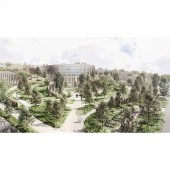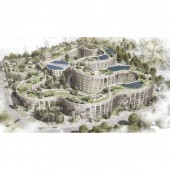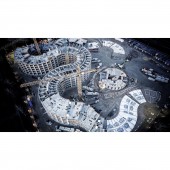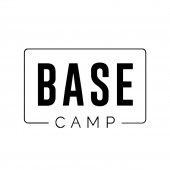BaseCamp Lyngby Student Housing by Lars Gitz Architects |
Home > Winners > #99940 |
 |
|
||||
| DESIGN DETAILS | |||||
| DESIGN NAME: BaseCamp Lyngby PRIMARY FUNCTION: Student Housing INSPIRATION: The concept and the organic form were inspired by the context. This part of the city has a very natural and green character that the building is in harmony with. The idea was to bring students closer to the nature and motivate them to interact with it. The project had to satisfy the low-cost an sustainability demand. A trapezoid repeatable shaped module that rotates differently within the same radius was invented, creating the round organic shaped structure. The structure is uninterruptedly running all the way through the site, creating a walking path in the nature on top of the building. UNIQUE PROPERTIES / PROJECT DESCRIPTION: Studentcampus BaseCamp Lyngby is built on a relatively flat site covering 34.300 sqm. while being well integrated into green Lyngby neighborhood. At the entrance to the plot, the building rises slowly from ground level to the maximum height of six floors, inviting both inhabitants and visitors to enjoy the multiple green courtyards or to take a stroll along the serpentine path running in full length at the roof. Great views, gardens and many species of smaller trees and bushes make for an interesting walk in the park like landscape. The curved shape of the building wraps around smaller courtyards, creating well defined intimate spaces for the students to meet, read or simply relax. OPERATION / FLOW / INTERACTION: Basecamp Lyngby is a serviced campus run by a team known as Basebuddies. All rooms are furnished and have private bathrooms. The majority have their own kitchenette to. The interior design is made by Studio Aisslinger and provides great qualities in the rooms and common areas. Common areas are designed to enhance social interaction. In the curved main building as kitchens and living rooms. The round central building is made solely for the students to meet and contains space for play, party, fitness, lectures and studying. PROJECT DURATION AND LOCATION: Construction start 06/01/2018 Expected construction completion date 08/01/2020 Location: Skovbrynet 2, 2800 Kongens Lyngby, Denmark FITS BEST INTO CATEGORY: Architecture, Building and Structure Design |
PRODUCTION / REALIZATION TECHNOLOGY: The building is certified at a DGNB Denmark “silver level”. The green roof provides a rainwater buffer, purifies the air, reduces the ambient temperature and saves energy. The facade is Rock Panel Durable and is certified BRE (Building Research Establishment) Class A+. 90 % of the energy of extracted air is reused in heating. Floor constructions accumulate heat during the day and minimize the need for heating at night. Facades are glazed in full height, so spaces are bathed in sun and daylight. SPECIFICATIONS / TECHNICAL PROPERTIES: The building of 37317 sq.m. lies on a 34300 sq.m. relatively flat site. It is 16,3 m wide and approx 1 km long. The buildings highest point is 22 m with its 6 levels in the south and from there it lowers its height all the way to the level 0 where the path connects. It is playfully wrapped around a vast common space in a round shaped building (1300 m 2) that visually reinforces the whole campus. Thus, bringing together all the shared functions and facilities by meeting the needs of students and residents of today and the near future. TAGS: Student housing, Residential architecture, Green roof, Sustainability, Nature interaction, Harmony RESEARCH ABSTRACT: The location is in the midst of beautiful nature, close to Lyngby Lake and the Unesco preserved park “Dyrehaven”. The city center and Denmark's Technical University (DTU) are reachable by bike within a few minutes. A 1000 bike parking spaces encourage the use of the greenest transport possible and the train station located nearby adds to this – thereby also making the capital, Copenhagen, reachable within only 20 minutes. The lake is just by the southern side of the plot, which provides the opportunity to hike, sail or kayak within a short reach. Since the project is relatively large for the area, it has been an ambition to give something back by making the roof park accessible for the public, and in that way improve and attract the local community in relation to social, economic, and environmental aspects. CHALLENGE: The biggest creative challenge in this project was to create interesting and context inspired architecture by keeping the costs very low. In order to achieve that, only one module would be repeated in ways that could create organic shapes. After a few months of research the trapezoid shape was invented. This repetitive module creates the organic looking serpentine structure playfully positioned around old vegetation that existed on the plot. ADDED DATE: 2020-02-21 13:40:27 TEAM MEMBERS (4) : Architect: Lars Gitz Architects , Architect: Jon Clausen , Architect: Nevena Milosevic and Constructive architect: Kim Clausen IMAGE CREDITS: Image #1: Illustrator Lars Gitz Architects, Front view, 2017 Image #2: Illustrator Kragh & Berglund Landscape architecture & Urban Design, Entrance, 2019 Image #3: Illustrator Lars Gitz Architects, Common building, 2017 Image #4: Illustrator Lars Gitz Architects, Site visualization, 2017 Image #5: Photographer BaseCamp Student, Work in progress, 2019 Video Credits: Kragh & Berglund Landscape architecture & Urban Design and Lars Gitz Architects, 2019 PATENTS/COPYRIGHTS: Copyrights belong to Lars Gitz Architects, 2020. |
||||
| Visit the following page to learn more: https://www.larsgitz.com/ | |||||
| AWARD DETAILS | |
 |
Basecamp Lyngby Student Housing by Lars Gitz Architects is Winner in Architecture, Building and Structure Design Category, 2019 - 2020.· Read the interview with designer Lars Gitz Architects for design BaseCamp Lyngby here.· Press Members: Login or Register to request an exclusive interview with Lars Gitz Architects. · Click here to register inorder to view the profile and other works by Lars Gitz Architects. |
| SOCIAL |
| + Add to Likes / Favorites | Send to My Email | Comment | Testimonials | View Press-Release | Press Kit |
Did you like Lars Gitz Architects' Architecture Design?
You will most likely enjoy other award winning architecture design as well.
Click here to view more Award Winning Architecture Design.








